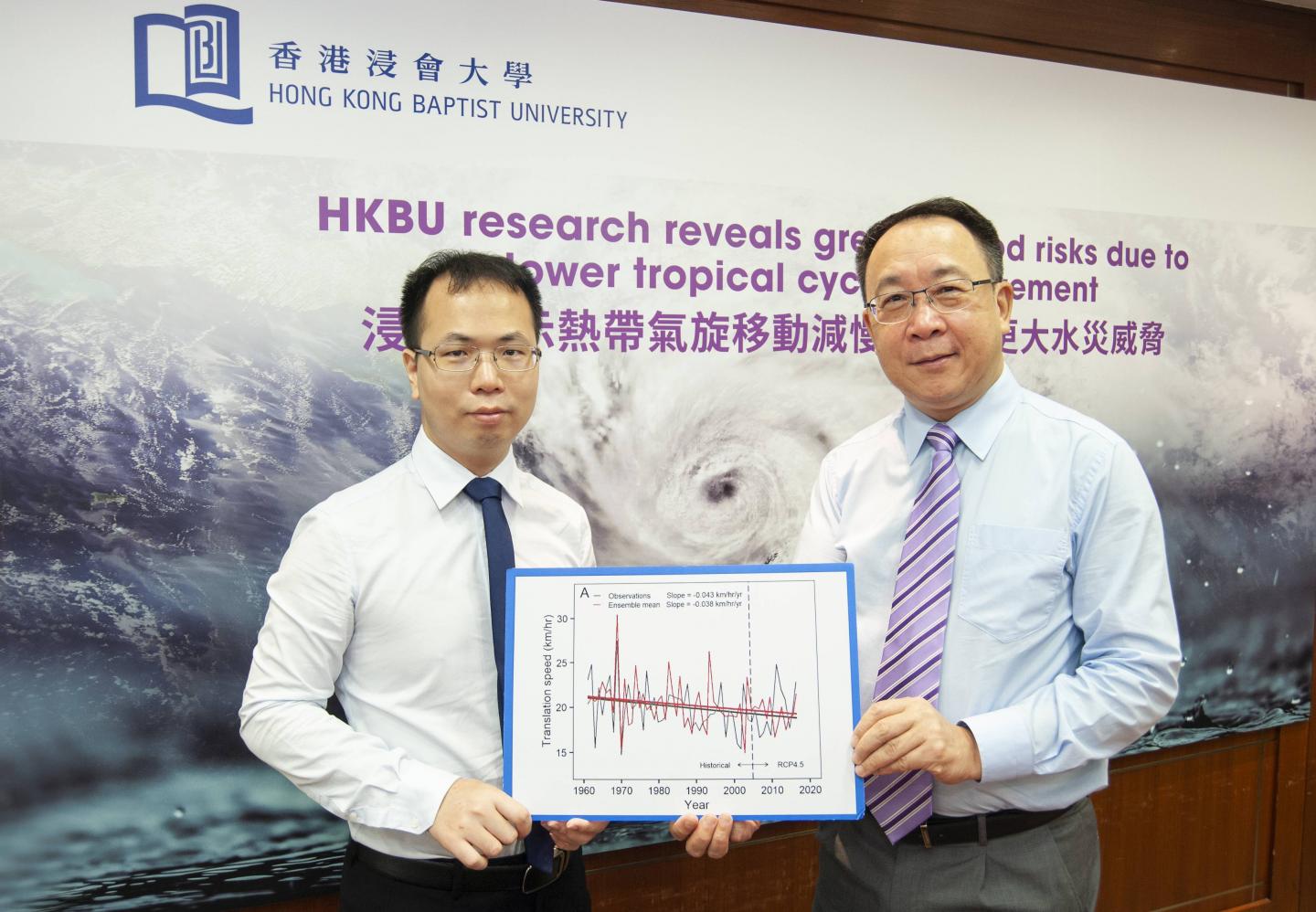
IMAGE: (Left) Dr Li Jianfeng, Assistant Professor of the Department of Geography at HKBU; (Right) Professor David Chen Yongqin, Professor of the School of Humanities and Social Science at CUHK-Shenzhen and…
view more
Credit: Hong Kong Baptist University
A research led by the Department of Geography at Hong Kong Baptist University (HKBU) has revealed that the observed average moving speed (or translation speed) of tropical cyclones making landfall over the coast of China dropped by 11% between 1961 and 2017. These slow-moving tropical cyclones brought about 20% more local total rainfall on average when compared with fast-moving ones, resulting in greater flood risks in the region.
The study also found that the occurrence of tropical cyclones with lower moving speeds and higher total rainfalls became more frequent after 1990 in the Pearl River Delta. The discovery offers invaluable insights that will enable the development of better flood management and adaptation strategies in the coastal region of China which is under threat due to tropical cyclones.
Over 400 tropical cyclones under study
The research team led by Dr Li Jianfeng, Assistant Professor of the Department of Geography at HKBU, studied 406 tropical cyclones which made landfall and lasted for more than two days over the coast of China, and specifically the Pearl River Delta where Hong Kong is located, between 1961 and 2017. The study, which started in 2018, aimed to investigate the trend of tropical cyclones’ moving speeds and its correlation with the volume of rainfall in the long run.
The research team analysed track data of the 406 tropical cyclones from the International Best Track Archive for Climate Stewardship (IBTrACS) and numerical simulations of eight Global Climate Models (GCMs) developed by meteorological and modelling centres around the world. IBTrACS is one of the most commonly used datasets for tropical cyclone studies, while GCMs are important tools for scientific communities to investigate and project climate behaviour.
Tropical cyclone’s moving speed correlates negatively with local rainfall volume
The team found that the observed moving speed of the tropical cyclones underwent a significant drop of 11%, decreasing from 21 km per hour in 1961 to 18.6 km per hour in 2017. The simulated moving speed also showed a drop of 10%, decreasing from 21.2 km per hour to 19.1 km per hour during the same period.
Data on the volume of local rainfall brought about by the 406 tropical cyclones was also examined. While the mean total volume of local rainfall increased by 8% between 1961 and 2017, the 90th percentile of the total volume of local rainfall increased even more significantly by 18%, rising from 187 mm to 223 mm. As a result, the data indicated an increase in extreme rainfall caused by tropical cyclones over the 57-year period examined.
Using statistical analysis, the team detected a negative correlation between the moving speeds of the tropical cyclones and their volume of local rainfall. The mean volume of local rainfall of slow-moving tropical cyclones with moving speeds of 15 km per hour or below was 99.1 mm, while that of fast-moving tropical cyclones with moving speeds of 25 km per hour or above was 80.5 mm. In other words, slow-moving tropical cyclones brought about 20% more rainfall on average when compared with fast-moving ones.
“The total amount of rainfall over a specific region brought about by a tropical cyclone is directly proportional to rainfall intensity, and inversely proportional to moving speed. The slower a tropical cyclone moves, the longer it spends passing over the region. As the region is affected for a longer duration, slower tropical cyclones bring about more rainfall,” said Dr Li.
Slow-moving tropical cyclones more frequent since 1990
The study further examined the correlation between the moving speeds of tropical cyclones and total rainfall in the Pearl River Delta. Among the 147 tropical cyclones that affected the Pearl River Delta between 1961 and 2017, 14 of them were slow-moving and had a rainfall intensity of 30 mm per day or more. Ten of them occurred after 1990, including three with a total volume of rainfall of more than 200 mm, indicating a substantial increase of flood risks caused by slow-moving tropical cyclones in recent years.
Among the 406 tropical cyclones examined in this study, 82 affected Hong Kong and moved within 200 km of the city. Out of these 82 tropical cyclones, 22 were slow-moving, and 14 of them (about 64%) occurred after 1990. They include Typhoon York in 1999 and Severe Tropical Storm Goni in 2009 which caused extensive damage in the region.
More holistic flood risk management strategies needed
“With analysis backed by long-term observations, we have provided evidence showing that slower tropical cyclone movement tends to elevate rainfall volume and thus it imposes greater flood risks at a regional scale. Therefore, more holistic and integrated flood risk management strategies, as well as flexible adaptation options, will be needed to deal with the growing threat of floods,” said Dr Li.
The research findings were published in the renowned scientific journal Proceedings of the National Academy of Sciences of the United States of America.
Apart from HKBU researchers, the research team also comprised researchers from Shenzhen University, China University of Geosciences, The Chinese University of Hong Kong (Shenzhen), University of Alberta, and Princeton University.
###
TDnews















